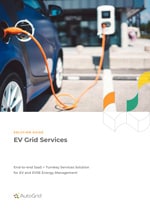In today’s digital economy, data on consumer behavior is gold. And when it comes to the explosive growth in electric vehicle (EV) adoption, the buzzword is “telematics.”
Based on the French word “telematique,” the term telematics refers to the convergence of telecommunications and information processing. Interest in telematics is spiking due to the immense volumes of data that can now be leveraged from EVs and supporting infrastructure to gain market insights including the behaviors of those who drive EVs. Typical automobile telematics, which were first introduced about three decades ago, include the following data streams:
- Global positioning system (GPS) data that can track vehicle movements on a geographic and time sequence basis
- On-board diagnostics revealing the status and performance of key operational components and systems
- Internet of Things (IoT) monitoring across multiple vehicles such as a fleet, enabling a big-picture view of potentially available grid assets
Telematics related to EVs (or any other consumer product) are dependent upon a cooperative ecosystem of diverse partners that can collaborate to provide reliable and actionable data. The more diverse the data sources, the more robust and revealing the data streams will be. This is especially important when attempting to manage data in real time and apply telematics to cutting-edge applications such as using EVs as a potential grid resource.
Given the nascent status of the EV industry – especially from a grid resource perspective – the quality of data tracking is vital to understanding new use cases for both hardware and software (and related business models.) The entire EV ecosystem needs to be on board in order for managed charging and more advanced vehicle-to-grid (V2G) applications to mature in the most sustainable manner possible.
What is an EV Ecosystem?
Today’s unfolding EV ecosystem includes car manufacturers, charging hardware providers, distributed energy resource (DER) aggregation and optimization software providers, utilities and the end users themselves, whether they be residential, commercial, industrial or institutional consumers. All can play a role in contributing to the most comprehensive telematics possible. Of course, in efforts related to grid sustainability, we focus most on the kinds of data that matter to utilities, grid operators, aggregators and those who provide the digital platforms to manage the charging of EVs in real time.
AutoGrid, along with a long list of other active EV market participants, is looking to telematics to inform its future EV strategy. Today, the EV market lacks a centralized database that provides regulators, utilities and other stakeholders a comprehensive view of consumer behavior when it comes to buying and operating their EVs. As noted by Uplight, a company that is part of AutoGrid’s and Schneider Electric’s EV ecosystem, 88% of EV charging happens at the home. This means that public data available on EV charging habits only reflects a very small part of the total market.
EV Fleets Are Current Focus
Challenges to EV adoption revolve around range anxiety and a hesitancy around trusting new technology with a resource so central to daily life. Cars and trucks are ubiquitous. Consumers today are used to dealing with maintenance issues such as oil changes, filling up the tank at gas stations, and other upkeep and repair routines. Despite the promise of much lower fuel costs, less ongoing maintenance and cleaner air, many consumers are reluctant to embrace new technologies such as EVs, especially those that appear to cost more upfront, even if the total cost of ownership for an EV is less than a traditional car running on gasoline.
These issues around consumer adoption make public and private EV fleets a better near-term opportunity to leverage telematics i. EV telematics allow EV fleet managers to run more efficiently and to adapt to how best to manage their fleets as the number of cars (and models) increase over time. A study performed by RAC estimated that almost 90% of new vehicles coming on the road by 2025 will share some form of connectivity, thereby enabling creative tracking of telematics.
There are two primary paths forward when it comes to leveraging telematics to create the largest portfolio of flexibility from the EV ecosystem. According to the Uplight article, “Having a comprehensive data platform that includes EV customer insights, EV program enrollments, and device and telematics data, enables utilities to create robust customer segments, maximize program enrollments and future proof for managed charging and infrastructure planning.” In short, telematics can drive the EV market on a more sustainable path since both public and private sectors will have the data they need to optimize both policy incentives and technology offerings.
We are at a fork in the road when it comes to accessing telematics and related data. These two fundamental paths – and their pros and cons – are described below.
Electric Vehicle Supply Equipment (Charging Infrastructure) Telematics
The least intrusive approach to gathering data on EV driving behavior and preferences is to go through the EV supply equipment (EVSE), which consists of the EV chargers and related infrastructure. On the surface, this might seem to be the optimal way to learn about what works best for the consumer, thereby improving either the products and services over time. If one’s goal is to dispatch EV charging to optimize grid operations during spikes or drops in demand, one needs high-fidelity data. Accessing EVSE allows a vendor, utility or grid operator to send real-time command signals to the device, an ideal way to shape behavioral demand response (DR). One can also directly schedule EV charging going this route, increasing the reliability of the EV to deliver on the promise of a reliable grid flexibility resource.
The downside to this approach is that not all EVs are dispatchable through EVSE telematics. Cost is also a concern. Requiring homeowners to install a separate electricity meter to participate in EV charging – which can cost as much as $1,200 – was an approach that failed to gain traction in the market. (This additional cost was no doubt a key factor.)
Direct EV Telematics
The other route to go is to collect telematics data directly from the EV itself. Under this scenario, telematics based-solutions communicate wirelessly between motor vehicles and the utilities by using the APIs that reside in the vehicle itself. One of the advantages of this approach is that not all EVSEs are Internet-connected products, whereas 80% of cars sold in the US today include built-in cellular connectivity. (For EV’s, the number is more like 100%.)
If one utilizes telematics from the EV, one can use data such as the state of charge (SOC) to make grid dispatch decisions. This telematics approach also makes a more direct connection with the overall driver experience, thereby educating drivers about how their EVs interact with the larger grid. This, in turn, can facilitate broader access and ultimately address some of the equity issues that have plagued the EV industry and other new emerging prosumer technologies in the past, such as rooftop solar PV. Finally, going directly to the EV for telematics enables more advanced managed charging capabilities, which will become increasingly important as EV adoption rates increase over time.
AutoGrid’s EV Ecosystem is Quickly Evolving
Solution providers seeking to access EV telematics for managed charging to provide demand response and ultimately more sophisticated grid services (such as frequency regulation) can sign agreements with auto manufacturers to communicate through APIs (with expressed consent from EV owners), use third-party software tools such as those offered by AutoGrid or reverse engineer an automaker’s APIs.
Some consumers might be hesitant to give access to their EV telematics to third parties. This same roadblock may challenge a host of other possible prosumer\ DER assets including HVAC systems, air conditioners, water heaters, rooftop solar PV systems and behind-the-meter batteries. Nevertheless, motor vehicles are mobile, and the freedom to access transportation services is well ingrained in popular culture, especially in the U.S.
Yet consumers are proving that they want to be prosumers and contribute to the climate change solution. Federal incentives for EVs included in last year’s Inflation Reduction Act (IRA) include substantial incentives for both new and used EVs. Yet in order to harness the full potential of EVs as a grid resource through managed charging and more advanced use cases, an entire EV ecosystem must build momentum by education, sharing of data and stakeholder engagement designed to advance the right policies and regulations to accelerate.
As more and more car manufacturers roll out EVs in the coming years, the EV ecosystem will continue to grow and evolve. The broader this ecosystem becomes, the better. No matter which approach to telematics one chooses, the most important stakeholders today are the car manufacturers themselves. At present, AutoGrid already has integrated with 26 different EV models, including the ever-popular lines of Teslas.
Leveraging the Power of the EV Ecosystem for Grid Resource Success
From a grid services vantage point, EV charger systems are critical to creating viable grid resource assets, no matter if they are leveraged for telematics or not. Enlarging the EV ecosystem allows AutoGrid the most flexibility in meeting the needs of the widest array of EV owners, whether private or public, single resident or corporate fleets. Again, AutoGrid is integrating with the top EV charting companies including Fermata, Enel X, Wall Box, JuiceBox and many others.
Yet another piece of the puzzle is charging station management software (CSMS). AutoGrid is also partnering with the companies that lead in this space such as EV Connect and EV Gateway, which may also provide guidance on existing government incentives to help defray costs.
The bottom line is that the broader the solution stakeholder ecosystem, the larger the opportunity in the EV space. Better data, more pathways to market and the ability to scale with multiple partners are all critical ingredients to success. The e-mobility market is not monolithic but consists of multiple segments, including early-adopter fleets, single-home residential and multi-family and condo homes. Finally, the capability to access telematics at both the EV and EVSE levels means that AutoGrid can capture the greatest amount of flexibility services across the world’s EVs, fine-tuning its approach to market regionally, horizontally and vertically. In short, AutoGrid can lead in the “EV as a grid resource” space, thanks not only to telematics, but also to the EV ecosystem it has created and is nurturing for the future.

EV Grid Solution Guide
End-to-end SaaS + Turnkey Services Solution for EV and EVSE Energy Management.





